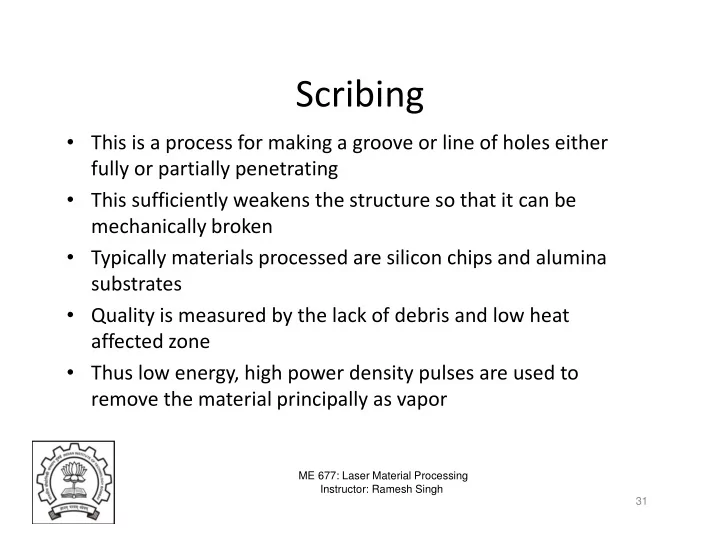

Scribing • This is a process for making a groove or line of holes either fully or partially penetrating • This sufficiently weakens the structure so that it can be mechanically broken • Typically materials processed are silicon chips and alumina substrates substrates • Quality is measured by the lack of debris and low heat affected zone • Thus low energy, high power density pulses are used to remove the material principally as vapor ME 677: Laser Material Processing Instructor: Ramesh Singh 31
Vaporization Cutting • The focused beam in vaporization cutting first heats up the surface to boiling point and generates a keyhole. • The keyhole causes a sudden increase in the absorptivity due to multiple reflections and the hole deepens quickly. • As it deepens so vapor is generated and escapes blowing ejecta out of the hole or kerf and stabilizing the molten walls of the hole of the hole • This is the usual method of cutting for pulsed lasers or in the cutting of materials which do not melt such as wood, carbon, and some plastics. ME 677: Laser Material Processing Instructor: Ramesh Singh 32
Vaoporization • The rate of penetration of the beam into the workpiece can be estimated from a lumped heat capacity calculation assuming – 1D heat flow – Conduction is ignored – Conduction is ignored – The penetration rate is similar to or faster than the rate of conduction – volume removed per second per unit area = penetration velocity, V m/s ME 677: Laser Material Processing Instructor: Ramesh Singh 33
Vaporization F [ ] ( ) 0 = ρ L + L + C T − T f v p v 0 V • 1-D heat flow [ ] 0 . 5 T ( 0 , t ) = ( 2 F / K ) ( α t ) / π 0 _ _ Time to vaporizati on 2 � � π T K � B � t = v � � α 2 F 0 ME 677: Laser Material Processing Instructor: Ramesh Singh 34
Cold Cutting • High powered UV Excimer lasers exhibit cold cutting – The energy of the ultraviolet photon is 4.9eV which is similar to the bond energy for many organic materials. – If a bond is struck by such a photon then it may break – If a bond is struck by such a photon then it may break – When this radiation is shone onto plastic with a sufficient flux of photons that there is at least one photon/bond then the material just disappears without heating leaving a hole with no debris or edge damage ME 677: Laser Material Processing Instructor: Ramesh Singh 35
Picture of Hair Micromachining via Excimer ME 677: Laser Material Processing Instructor: Ramesh Singh 36
Effect of Spot Size • The principle parameters are laser power, traverse speed, spot size and material thickness . • Spot size acts in two ways: – Firstly, a decrease in spot size will increase the power density which affects the absorption and density which affects the absorption and – Secondly, it will decrease the cut width. • Lasers with stable power and low order modes - usually true TEMoo modes cut considerably better than other modes ME 677: Laser Material Processing Instructor: Ramesh Singh 37
Spot Size ME 677: Laser Material Processing Instructor: Ramesh Singh 38
Effect of Beam Polarization • The maximum cutting speed could be doubled, cutting in one direction as opposed to one at right angles when cutting with a plane polarised laser beam. • Nearly all high powered lasers have folded cavities which favours the amplification of radiation whose electric vector is favours the amplification of radiation whose electric vector is at right angles to the plane of incidence. ME 677: Laser Material Processing Instructor: Ramesh Singh 39
Wavelength • The shorter the wavelength the higher the absorptivity for most metals • Thus YAG radiation is preferable to CO2 radiation but the poor mode structure of most radiation but the poor mode structure of most YAG lasers the benefit is offset • Fiber lasers with good beam mode could have an advantage ME 677: Laser Material Processing Instructor: Ramesh Singh 40
Summary • Basics of laser cutting • Mechanisms • Factors affecting laser cutting ME 677: Laser Material Processing Instructor: Ramesh Singh 41
Laser Welding Laser Welding ME 677: Laser Material Processing Instructor: Ramesh Singh 1
Outline • Process Description • Mechanisms of Laser Welding ME 677: Laser Material Processing Instructor: Ramesh Singh 2
Laser Welding-Basics • Laser welding is a non-contact process that requires access to the weld zone from one side of the parts being welded • The weld is formed as the intense laser light rapidly heats the material-typically calculated in milli-seconds. • There are typically three types of welds: – Conduction mode – Conduction/penetration mode – Penetration or keyhole mode. ME 677: Laser Material Processing Instructor: Ramesh Singh 3
Laser Welding-Basics • Conduction mode welding is performed at low energy density forming a weld nugget that is shallow and wide. • Conduction/penetration mode occurs at medium energy density, and shows more penetration than conduction mode. • The penetration or keyhole mode welding is characterized • The penetration or keyhole mode welding is characterized by deep narrow welds. – In this mode the laser light forms a filament of vaporized material know as a “keyhole” that extends into the material and provides conduit for the laser light to be efficiently delivered into the material. – This direct delivery of energy into the material does not rely on conduction to achieve penetration, and so minimizes the heat into the material and reduces the heat affected zone. ME 677: Laser Material Processing Instructor: Ramesh Singh 4
Recommend
More recommend